Carthaginian Army › Carthaginian Art › Enki in Ancient Literature » Origins and History
Articles and Definitions › Contents
- Carthaginian Army › Origins
- Carthaginian Art › Origins
- Enki in Ancient Literature › Origins
Ancient civilizations › Historical places, and their characters
Carthaginian Army › Origins
Definition and Origins
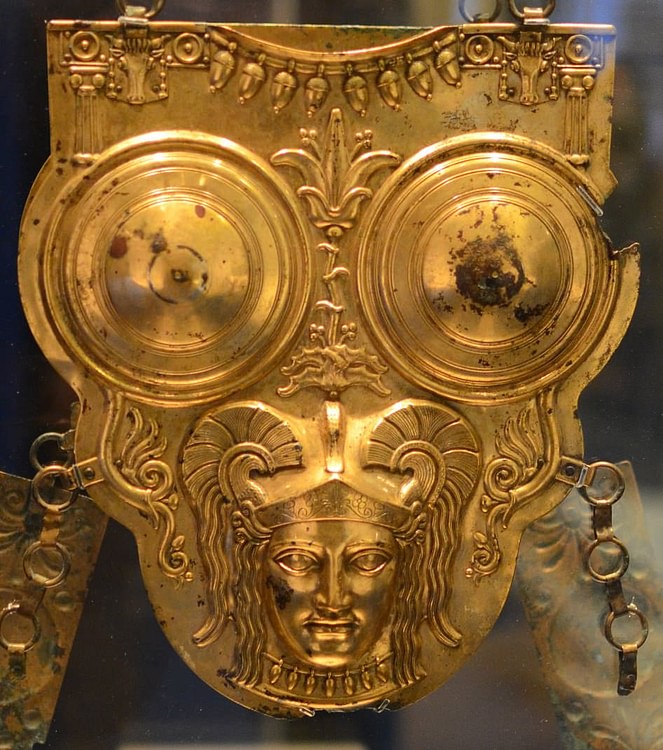
The armies of Carthage permitted the city to forge the most powerful empire in the western Mediterranean from the 6th to 3rd centuries BCE. Although by tradition a seafaring nation with a powerful navy, Carthage, by necessity, had to employ a land army to further their territorial claims and match their enemies. Adopting the weapons and tactics of the Hellenistic kingdoms, Carthage similarly employed mercenary armies from their allies and subject city-states. Military successes came in Africa, Sicily, Spain, and Italy, where armies were led by such celebrated commanders as Hamilcar Barca and Hannibal.Carthage's military dominance was, though, eventually challenged and bested by the rise of Rome and, following defeat in the Second Punic War (218-201 BCE), Carthage's days as a regional powerhouse were over.
THE CARTHAGINIAN EMPIRE
Carthage was founded in the 9th century BCE by settlers from the Phoenician city of Tyre, but within a century the city would go on to found colonies of its own. An empire was created which covered North Africa, the Iberian Peninsula, Sicily, and other islands of the Mediterranean. The new territory would be a source of vast wealth and manpower. Conversely, this would also bring Carthage into direct competition not only with local tribes but also contemporary powers, notably the Greek potentates and later Rome. In turn, this created a necessity for large military forces, especially land armies.
COMMANDERS
The commander of a Carthaginian army in the field ( rab mahanet ) was selected for the duration of a specific war, usually from the ruling family. The general may often have had complete autonomy of action or, on other occasions, had to rely on the council of 104 and the two most important political persons at Carthage, the two suffetes (magistrates), for such important decisions as when to hold a truce, sue for peace, or withdraw. In addition, after a battle or war, the commanders would be subject to a tribunal which investigated their competence or otherwise. Different family groups within Carthage had their own private armies, which could then be employed for the state; a situation which caused intense rivalry between commanders. In addition, command was sometimes shared between two, or even three, generals, creating more opportunities for fierce competition.
THE CARTHAGINIAN ARMY WAS COMPOSED OF CITIZEN HOPLITES, AFRICAN CAVALRY, & MERCENARIES FROM ACROSS THE EMPIRE.
Motivation must have been high as those generals who failed in wartime were treated harshly. One of the lesser punishments was a large fine whilst the worst case scenario was crucifixion. Several commanders, following defeat, committed suicide to avoid the latter penalty, although, this did not stop the council of 104 crucifying the corpse of one Mago c. 344 BCE. A serious consequence to the fear of failure inherent in the army command structure may have been that generals tended to be over-cautious and conservative in battle.
ORGANISATION
The army of Carthage itself was composed of heavily armoured infantry drawn from the citizenry. This was an elite group of 2,500-3,000 infantry soldiers identified by their white shields and known as the Sacred Band. The name is copied from the elite army of Greek Thebes and indicates a general move away from Near Eastern practices to a Hellenization of the Carthaginian military from the 4th century BCE. The Sacred Band was barracked within the massive fortification walls of Carthage. A second source of troops was the allied cities and the conquered territory of North Africa, especially ancient Libya and Tunisia.These would have been led by Carthaginian officers and were paid for their service.

Carthaginian Sacred Band Hoplite
As neither of the previous two groups were very numerous or enjoyed a particularly glorious reputation in battle – after all, the Carthaginians were noted for their navy – a third group of professional mercenaries was relied upon to create an army which could match the enemies of Carthage. These came from all Carthage's allied and conquered states around the Mediterranean, especially Greece, Iberia, Gaul, and southern Italy. Another notable component of a Carthaginian army in the field was the highly skilled Numidian cavalry whose riders armed themselves with a javelin and rode without a bridle, such was their skill in controlling their mount. They carried a small shield for protection and also threw long poisoned darts at the enemy. An unusual contingent of mercenaries came from Libyan-Egyptian lands which fielded women in battle, usually riding chariots or horses.They carried crescent-shaped pelta shields and wielded double axes.
All of these groups of mercenaries remained a permanent fixture of the Carthaginian standing army from the end of the 3rd century BCE. To avoid the threat that successful mercenary armies took it into their heads to depose the ruling elite of Carthage and take the city's wealth for themselves the Carthaginians made sure that all senior and middle command positions were held by citizens of Carthage. Nevertheless, despite this precaution, in several instances mercenary armies would prove to be disloyal and even cause in-fighting between the rival clans of Carthage's aristocracy, most famously during the Truceless War (aka Mercenary War, 241-237 BCE).
WEAPONS & ARMOUR
As the armies of Carthage were usually composite groups of Punic, African, and foreign mercenary forces their weapons and armour differed depending on the unit's origin or preferences. In addition, the Carthaginians were not averse to equipping themselves with the arms and armour of their fallen enemies. Contact with Greek forces in Magna Graecia and Sicily resulted in the Carthaginians themselves adopting such quintessentially Greek paraphernalia as the crested bronze Corinthian and Thracian helmets and heavy hoplite armour (a metal or leather tunic and greaves to protect the lower legs). Older style conical helmets were worn, as were helmets with face masks and metal breastplates covered in leather copied from Cypriot armour. The strengthened linen cuirass ( linothorax ) studded with bronze bosses and with hanging strips ( pteryges ) to protect the groin were also copied from Greek warriors.
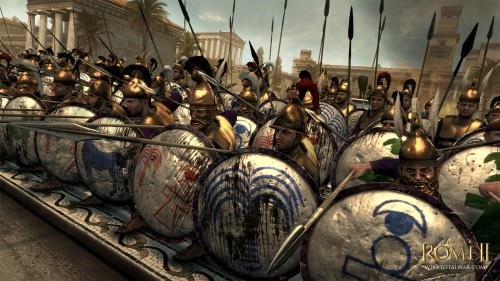
Carthaginian Mercenaries
Shields were circular (around 90 cm in diameter) or oval with a central vertical rib (the thyreos-type), although Celtic troops, for example, had a narrow rectangular shield of oak. Shields were decorated with motifs related to Punic religion, classic motifs such as Medusa, the Evil eye, or even personalised – Hasdrubal Barca had his own portrait on his silver shield. The Carthaginians seemed to have dressed up for battle with plenty of gold jewellery and animal skins being worn, especially by officers. Carthaginian officers would have further stood out in the heat of battle due to their impressive helmet plumes and glinting precious-metal armour. Generals often had expensive scale armour, such as that worn by Hannibal made from gilded bronze scales and inherited from his father.
The typical weapon was the sword, either with a straight blade or a curved single-edged one, the kopis of the Near East, with a dagger as a backup. Celts famously used long slashing swords while Iberian infantry had distinctive curved swords. Spanish tribes also used a short sword with great effect; something which did not go unnoticed by the Romans who would later adopt a similar type themselves, the gladius hispaniensis.
Archers were used, especially the skilled Moors and Cretans, but much less than in other armies. Bowmen were chiefly employed in chariots or on elephants to fire down on opposing infantry. Other weapons used were spears (3-6 m in length), short javelins (the principal cavalry weapon) and double-headed axes ( bipennis ). Slings were used to fire lead or stone bullets which were almond-shaped for maximum penetration into armour. They were especially used by the deadly mercenary slingers from the Balearic Islands.
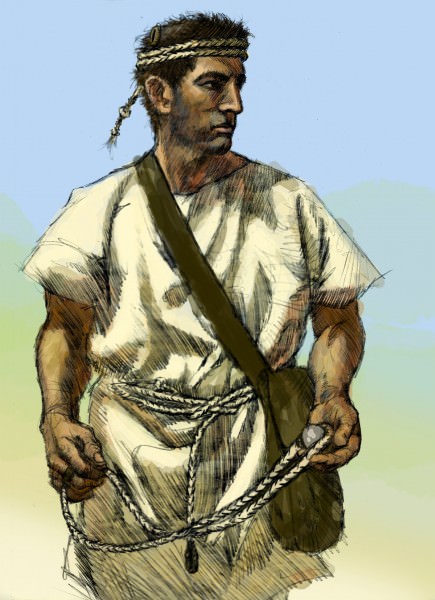
Balearic Slinger
Artillery was a component of Carthaginian armies in Sicily where the cities were well-fortified. The Carthaginians were quick to copy the Hellenistic inventions of catapult (for stones and incendiaries) and crossbows. During a siege, they also employed battering rams, mobile siege towers, mounds, and mining to overcome enemy fortifications. We know that Carthage itself was equipped with artillery machines for defence.
CHARIOTS
The Carthaginians employed war chariots up to the 3rd century BCE. These were constructed from wooden frames covered with panels of woven willow branches. They were single-axle chariots and could carry two men: a driver and an archer.Sometimes a third man, a hoplite, would join them. The wheels could be fitted with blades, and the team of two or four horses was protected with metal breastplates and ox-hide side covers. Like cavalry, they were used to break up the enemy infantry lines. Needing flat terrain to operate effectively they were largely restricted to use in North Africa and southern Spain and went completely out of use from the 3rd century BCE.
WAR ELEPHANTS
The Carthaginians used in warfare a now extinct variety of elephant once native to North Africa. Although, Hannibal may have had some larger Indian elephants via his ally Ptolemy II of Egypt. Tusked and reaching a height of 2.5 metres, the elephants were made even more fearsome by adding armour to the head, trunk, and sides and blades or spears to the tusks. Controlled by their driver ( mahout ) they were used to disrupt enemy formations. Not large enough to carry a superstructure ( howdah ), this variety of elephant may have permitted a second rider armed with a bow or javelins. Before battles, elephants would be given fermented wine to make them behave more erratically and increase their trumpeting and stamping. No doubt the appearance and noise of elephants caused panic amongst the enemy's men and horses, but they were wildly unpredictable in battle and could cause as much damage to their own side as the opposition. When enemy forces became used to them and trained their horses not to panic, or if the terrain was unsuitable, then their effectiveness was greatly reduced.
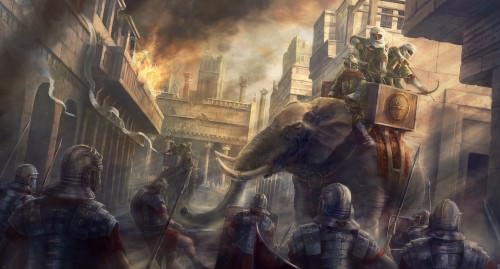
Carthaginian War Elephant
STRATEGIES & TACTICS
After an initial round of skirmishes involving light cavalry, the Carthaginian army attacked the enemy head-on with heavy infantry, much like the Greeks had been doing for centuries with the phalanx (a line of tightly grouped hoplites protecting each other with their shields). Following the successful Macedonian model of a speared phalanx, the Carthaginian army was similarly organised into companies of around 250 men organised into 16 lines of 16 troops, which then collectively formed battalions of around 4,000 men. Light infantry was stationed on the wings and protected the flanks of the phalanx which might draw in the enemy lines. Troops were coordinated during battle using standards which, for Carthaginian units, were staffs with ribbons topped by the familiar Punic crescent moon and sun disc symbol. Each ethnic group would have had their own standards such as the Celtic wild boar image and shield blazons were also used to identify who was who.
The elephant corps was used in front of the infantry to disrupt the opposition ranks and light cavalry units to harass the enemy from the wings or rear. There was also a small unit of heavy cavalry, composed of Carthaginian citizens only, which could break up the enemy's infantry lines mid-battle. Cavalry was also used to harass the enemy when in retreat. When not involved in head-to-head battles, the cavalry, especially the mobile and highly manoeuvrable Numidian corps, were used to ambush enemy troops or lead them into ambush by infantry troops.
In some battles, the Carthaginian army numbered up to 70,000 men (but more often less than half that figure) and its success was very much down to the commander's ability to galvanise all of the disparate groups into a cohesive fighting force. Hannibal was particularly renowned for his ability in this area and in his willingness to adapt superior enemy tactics and formations such as after the Battle of Lake Trasimene (217 BCE) when he likely adapted the more flexible Roman maniple troop deployment as opposed to the more static phalanx.
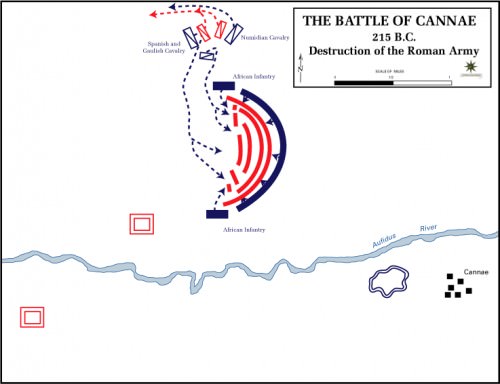
Battle of Cannae - Destruction of the Roman Army
CONCLUSION
In some theatres the Carthaginian army enjoyed great successes, notably in North Africa, Sicily, Spain, and Italy where Hannibal famously won four great battles against Rome. However, the Second Punic War was perhaps a turning point. The Roman general Scipio Africanus managed to persuade the Numidian cavalry to join his cause and defeated Hannibal and his elephants at the Battle of Zama (202 BCE). Rome, with its standardised, well-equipped and well-drilled armies, which could be replaced from a seemingly never-ending supply of manpower and wealth, had taken ancient warfare to a new level of professionalism. The inherent weaknesses in the Carthaginian army - disparate groups of sometimes disloyal mercenaries, confused command structures, and an over-reliance on heavy infantry and war elephants - meant that Carthage was, ultimately, unable to maintain its position as a Mediterranean superpower and keep pace with mighty Rome.
Carthaginian Art › Origins
Definition and Origins
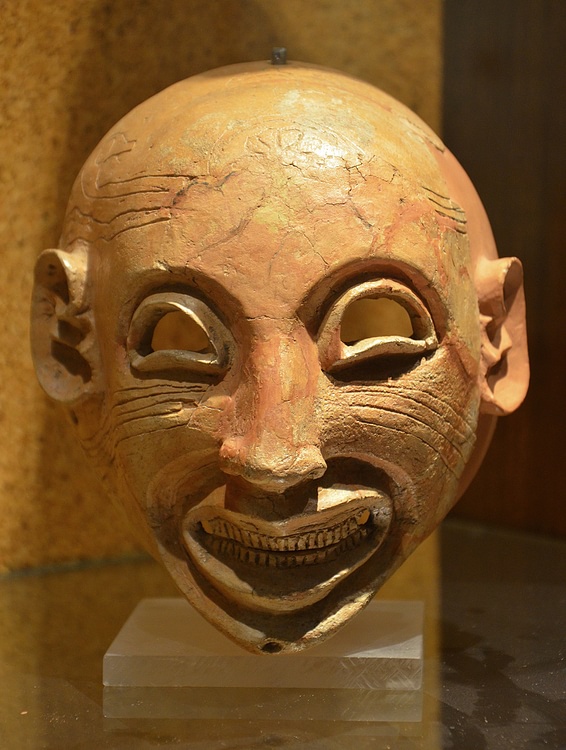
The art of the Carthaginians was an eclectic mix of influences and styles, which included Egyptian motifs, Greek fashion, Phoenician gods, and Etruscan patterns. Precious metals, ivory, glass, terracotta, and stone were transformed into highly decorative objects ranging from everyday utensils to purely ornamental pieces. Just as the Carthaginians imported and exported all manner of trade goods, so too their art reflected their vast network of contacts across the ancient Mediterranean but they would eventually produce their own distinctive art which uniquely blended elements from other cultures. The distinctive qualities of Punic art can be best seen in their stelae, jewellery, sculpture, and masks.
Surviving examples of Carthaginian art are sadly few in comparison to contemporary cultures, and they are further limited in scope by the fact that the majority of artefacts come from a burial context and so are predominantly small in scale and of a religious nature. Secular art and objects produced exclusively for their aesthetic value are rare indeed. Nevertheless, enough examples survive of jewellery, figurines, ceramics, and stonework to hint that the Carthaginians were not as artistically impoverished as earlier historians saw fit to claim.
INFLUENCES
Carthage was founded in the 9th century BCE by colonists from the Phoenician city of Tyre. This fact and the city's continued close ties with the mother country meant that art was heavily influenced by that of Phoenicia, at least in its formative years.Just as Phoenicia was itself a melting pot of diverse cultures, its wealth based as it was on maritime trade, so too Carthage would become a cosmopolitan city with visitors, residents, and artists from across the ancient Mediterranean. Egyptian artwas particularly influential and many motifs are seen in Carthaginian art such as the goat with head looking backwards beneath a sacred tree or rigid standing female figures. Near Eastern art was another strong influence, seen especially in figurines of the god Melqart /Baal. The influence of Etruscan artists is seen especially in Carthaginian pottery decoration from the 4th century BCE.
CARTHAGINIAN ARTISTS REPEATED, COMBINED, & EVOLVED MOTIFS FROM EGYPTIAN, NEAR EASTERN, & GREEK ART TO PRODUCE AN ECLECTIC MIX OF STYLES.
Above all, though, Carthage's art took inspiration from the Greek world from the 5th century BCE onwards. Not only were the Carthaginians appreciative collectors of Greek art, taking fine art as booty from their campaigns in Sicily, but they also produced imitative art. There was a large Greek community at Carthage, and many of these must have worked as skilled craftsmen in the workshops of the city. In turn, they would have taught local artists or the next generation. We know of at least one artist whose father was a Greek immigrant but who signed his work as 'Boethus the Carthaginian' and who became so appreciated that his work was dedicated at Olympia.
There is a general problem of identifying the exact origin of many art pieces which is exacerbated by the Punic habit of copying foreign motifs and styles. Traditionally, historians had favoured the view that, at least in general, finer pieces were imported and more rustic art was locally made. This unflattering view is steadily being revised following the discovery of large workshop areas in the city suggesting a healthy export trade and by new archaeological discoveries so that the position that all of the fine art was imported is becoming increasingly untenable.
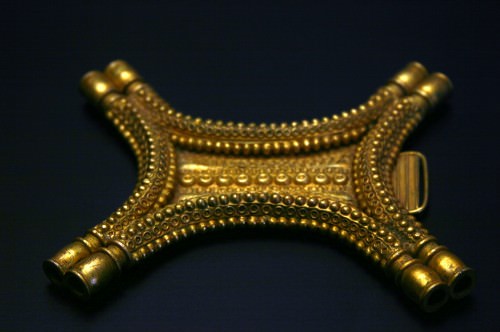
Phoenician-Punic Gold Pectoral
MATERIALS
The materials used by Carthaginian artists were many. Coloured glass and glass paste were used to make jewellery beads and small perfume amphorae. Ivory was carved to make decorative plaques which could be hung on walls or added to furniture. Sometimes semi-precious stones, glass or faience were added to these plaques for extra sparkle. The same material was carved to make such everyday items as knife and mirror handles, combs, small boxes, and intaglios. Terracotta was used to make figurines of deities, masks, incense burners, and simple cups, bowls, and trefoil-jugs. It was also used to make circular decorative plaques. Gold was employed for jewellery and could be hammered, cast, granulated, repoussé, or applied as gold leaf. Surviving gold pendants take the form of fruit, small busts, and objects from nature such as a chrysalis.Stone, in rare cases also marble, was carved to produce tomb stelae, ossuaries, and small temples placed above graves.Bronze was employed for figurines, and especially common were hatchet razors. Left with the deceased in tombs for use in the after-life, they often have a swan or ibis-headed handle and were beautifully incised with images of gods from the Phoenician, Greek, or Egyptian pantheon.
COMMON MEDIA & THEMES
Figurines & Masks
Figurines of a female goddess, probably considered a protectress, are a relatively common dedication in early tombs and graves. They were also offered either as a request for or in thanks for healing. The figures are simply rendered with a flat-topped head and cylinder body. Figurines of the god Melqart sitting on a throne, with his right hand raised in blessing, and typical conical hat were produced in large numbers, too.
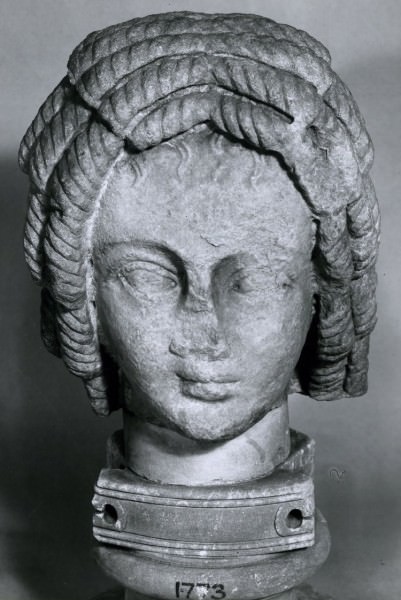
Carthaginian Portrait Bust
From the 4th century BCE many figurines display a Greek influence, especially in their clothing such as the chiton and peplosrobes, and himation cloak. Although the Carthaginians applied many conventions of Greek art to their own figure sculpture, it is striking that one element they did not adopt was the nude. Punic figures are always clothed. Female figures playing tambourines have been excavated at various Carthaginian sites, and some of these figures blend Greek clothing with Egyptian winged-portrayals of Isis wearing a typical Egyptian, wide collar. As with Greek sculpture, these human figures were originally brightly painted.
Cavalry riders appear in several mediums, notably on a 6th century BCE terracotta circular plaque from Douimes. The warrior wears a crested helmet, carries a circular shield, and has his dog running alongside his horse. Another terracotta product was receptacles in the shapes of animals, ducks, and cow's heads.
Grinning masks, made from painted, incised, and stamped terracotta, were given lively grimacing expressions and deep wrinkle lines. With empty eyes and open mouths, they were left in tombs in order to ward off evil spirits or hung on walls of houses for the same purpose. They were certainly not worn as they are less than life-size. These masks were produced in large numbers but are all unique. A second type was masks of smiling female faces ( protomai ), but these were not grotesque like the male versions. Both types could be made using moulds.
Jewellery
Necklaces composed of individual glass beads shaped into male heads are a typical item of Carthaginian jewellery. Each face has curly hair, a beard, and the large staring eyes so often seen in the faces of Punic art. Beads were also made from gold, silver, and pearls. Pendants, earrings, bracelets, nose-rings, ankle-rings, and diadems were all worn by the Carthaginians who could afford them. As with Egyptian jewellery, lions, falcons, gods, lotus blossoms, and palmettes were typical forms of decoration. Many vitreous paste beads carry eye motifs. Carthaginians, also like the Egyptians, carried tiny papyrus scrolls on their person which had written on them spells and formulas against all manner of potential disasters. These scrolls were kept in precious metal boxes incised with the motifs just mentioned.
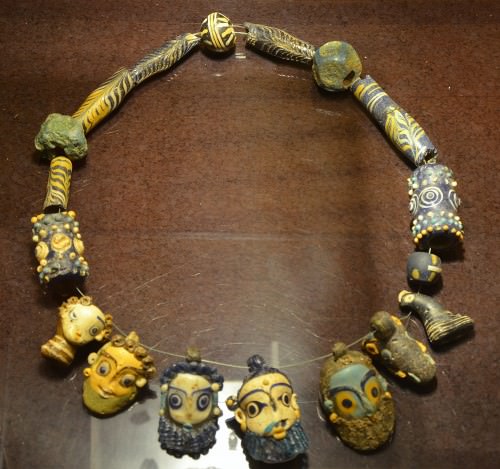
Carthaginian Necklace
Amulets of glass paste covered by enamel and carved seals of gold and semi-precious stones (eg agate and jasper) often depicted Egyptian deities such as Bes, Ptah, and Isis, or took the form of familiar Egyptian symbols like the ujat eye, crown of Upper Egypt, and lotus flower. Scarabs were produced in large numbers at Carthage too and were carved from jasper, cornelian, lapis lazuli, agate, rock crystal, basalt, and glass paste. They were worn as protection against all kinds of mishaps, as symbols of social rank and citizenship, or as a means to increase the healthiness of particular parts of the body. Intaglios are another area of Greek influence. These incised ivory jewellery pieces often depict scenes from Greek mythology, especially involving Dionysos and Demeter.
Decorative Objects
One of the most common Punic decorative objects and a popular export was ostrich eggs. These usually have their tops cut off, but some are complete and were drained through a single small hole in the base. They were decorated with geometric forms, palms, and lotus blossoms using red paint. Symbolising regeneration or the cosmic egg of creation they were a common votive offering in tombs. Another use was to paint fragments of the shells with faces to create miniature masks.
Glass was used to produce small two-handled vessels used for storing perfumes. These had been long-produced in Phoenicia and Egypt, but the Carthaginian type is distinctive for its very dark blue glass decorated with yellow, white, or turquoise stripes achieved by adding thin trails of hot glass over the inner main shell.
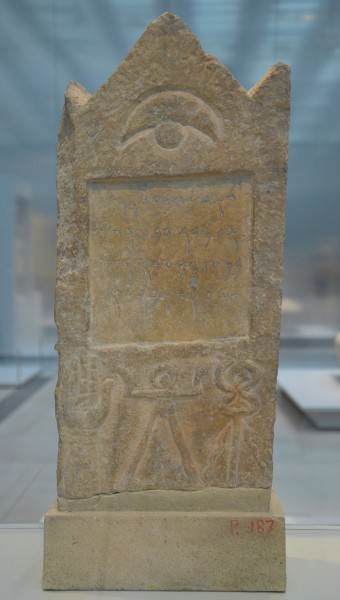
Punic Stele with Goddess Tanit
Stelae
Sandstone and limestone stelae measuring up to 1.5 metres in height are the most common medium of Punic art which survive. They were carved for placement above tombs, especially in the tophet, where many carry a lozenge-shape, hexagon, or bottle-shaped decoration, or the symbol of Tanit. The earliest type (7th-6th century BCE) was a miniature architectural model of a temple or altar shaped like a throne. These are known as cippi (sing. cippus ) and they often copied the facades of Egyptian temples and were topped by a solar disk and/or a crescent moon. Later types (from the 5th century BCE) have a triangular top and took inspiration from Greek architecture with Ionic columns and winged sphinxes used as common decorative features. An outstanding example of the eclectic mix of Carthaginian art is the stele set above the tomb of Hadrumetum, c. 250 BCE in the tophet of Carthage, with its single Ionic column topped by a sphinx above which are Egyptian-like palm fronds.
From the 3rd century BCE, portraiture was sometimes attempted and many stelae have animal figures, a hand motif, and a male figure seated on one bent leg. The exact significance of these and the earlier geometric motifs is still debated amongst historians. Many stelae show traces of stucco and paint and their production was in no way interrupted by the Romandestruction of Carthage in the mid-2nd century BCE.
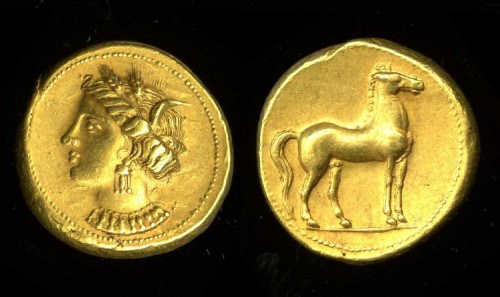
Carthaginian Electrum Coin
Sarcophagi
Sometimes, instead of a stele, tombs had a carved stone ossuary to preserve the bones of the deceased. Of Near East origin, these could present a full-length representation of the deceased on the lid and reproduce a life-like portrait of the face. One such example is the 4th-3rd century BCE ossuary of a priest from the Santa Monica cemetery at Borj-el-Jedid. Full-size Punic sarcophagi generally mixed Egyptian forms with a Hellenistic portraiture of the occupant on the lid. The earliest are the most Egyptian, and the person is represented in a flat view, and then, as Carthage saw more Greek influence in art in general, the figures become more three-dimensional.
Coinage
Punic coins were minted in Sicily from the 5th century BCE and at Carthage itself from the 4th century BCE. The most common designs include a horse's head, a full horse with Nike above, a single palm tree, Melqart with a club like Hercules, a war elephant, the prow of a warship, a lion in front of a palm tree, and head of a female goddess (especially Tanit, less often Demeter and Kore) which were all stamped on both sides of coins of silver, gold, electrum, and bronze.
Enki in Ancient Literature › Origins
Ancient Civilizations
Enki is a god of Sumerian mythology and, later in time, known as Ea in Babylonian mythology. He was the deity of sweet water, crafts, creation, intelligence, the god of wisdom and of all magic, and was the patron god of the city of Eridu before his cult spread throughout Mesopotamia. He is the son of Nammu and father of Inanna and is the third of the trinity ( Anu - Enlil-Enki) heading the Sumerian pantheon. The main temple to Enki is called E-abzu, meaning “house of the subterranean waters”, a ziggurat temple near the ancient Persian Gulf coastline at Eridu. He was the keeper of the divine powers called me-s (Tablets of Destiny), gave the gifts of civilization, and was sometimes depicted as a man covered with the skin of a fish. He is also significant in Akkadian mythology as the father of Marduk, the national god of Babylon. In this article we will examine the portrayal of Enki in various literary sources.
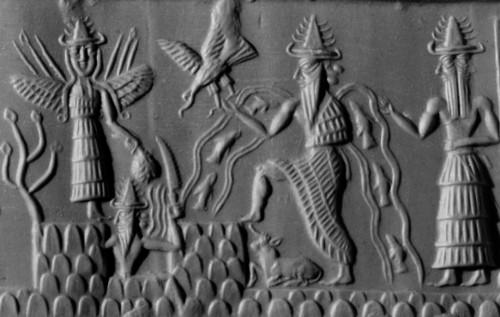
Enki on the Adda Seal
NAME & LITERATURE
Enki is the creator and protector of humanity and is undoubtedly the most important and most often treated hero of Sumerian mythology. The earliest evidence concerning Enki can be traced to the archaeological finds in his ancient temple in Eridu. A common translation of his name is “Lord of the Earth” but scholarly debate continues. In his Master's Thesis “Ancient Near Eastern Gods Enki and Ea” Peeter Espak writes:
SN Kramer or Th. Jacobsen interpreted the name “Lord of the Earth.” They both concluded that the name en-ki was not an original name of the deity but an epithet given to the god by later theological speculation. The main reason for such a conclusion was the consideration that the name “Lord of the Earth” does not correspond directly to the functions of Enki. Th. Jacobsen found a solution to the problem by claiming that Enki is the power in water giving shapes to the clay (ie Earth). SN Kramer, in turn, believed that Eridu oriented theologians and priests gave the name “Lord of the Earth” to the god in their attempt to secure Enki's position as the leading deity alongside Enlil.
Enki has been mentioned, amongst others, in the following epics or texts, although a serious chronological problem arises because it is not possible to give an exact dating for a piece of literature based on the approximate date of composition of a tablet:
- Enki and the World Order
- Enki and Ninhursag
- Atrahasis
- Enmerkar and the Lord of Aratta
- Enki and Inanna
- Enuma Elish
- The Death of Gilgamesh
THE CULTURAL HERO & CREATOR OF MANKIND
ENKI & THE WORLD ORDER
The well-preserved Sumerian mythological composition Enki and the World Order (Tablet AO 6020, acquired by the Louvre in 1912 CE, ca. 472 lines) provides a detailed account of Enki's activities in instituting civilization and culture, which leads Peeter Espak to note in his dissertation "The God Enki in Sumerian Royal Ideology and Mythology" that: 'He is the care-taker of the settled people and the organizer of a civilized world. For achieving his task of being the cultural hero of mankind and of the gods, he receives the me-s from the Anunna-gods, An and Enlil.' (12).

Enki
The date of composition of Enki and the World Order is not clear, possibly at the end of the 3rd Millennium BCE and it was probably re-worked and inscribed as we know it now at the time of the Third Dynasty of Ur (c. 2000 BCE), as demonstrated by Professor Jean Bottéro (1992).
Enki and the World Order is composed of four sections and starts with a third-person praise to Enki:
Grandiloquent lord of heaven and earth, self-reliant, Father Enki, engendered by a bull, begotten by a wild bull, cherished by Enlil, the Great Mountain, beloved by holy An, king, meš tree planted in the Abzu, rising over all lands; great dragon who stands in Eridug, whose shadow covers heaven and earth, a grove of vines extending over the Land, Enki, lord of plenty of the Anuna gods, Nudimmud, mighty one of the E-kur, strong one of heaven and earth! Your great house is founded in the Abzu, the great mooring-post of heaven and earth. Enki, from whom a single glance is enough to unsettle the heart of the mountains; wherever bison are born, where stags are born, where ibex are born, where wild goats are born, in meadows ……, in hollows in the heart of the hills, in green …… unvisited by man, you have fixed your gaze on the heart of the Land as on split reeds.
Enki then praises himself twice in the first person and tells how Enlil instructed him and gave him the gift of the me-s. He intends to take a journey through Sumer in order to fulfill his commission to arrange proper order and affluence in Sumer. In the third part, Enki proclaims the destiny of Sumer during his journey through the land. He visits Ur in central Sumer but also Magan, Meluhha, and Dilmun in the surrounding regions. When he comes back to the Sumerian homeland, he assigned selected deities to take charge of the functions of various regions of the Sumerian world order. Inanna complains in the last part that Enki did not assign any powers in the proclamation of destinies to her.
Enki answers (excerpt):
Inana, you heap up human heads like piles of dust, you sow heads like seed. Inana, you destroy what should not be destroyed; you create what should not be created. You remove the cover from the šem drum of lamentations, Maiden Inana, while shutting up the tigi and adab instruments in their homes. You never grow weary with admirers looking at you. Maiden Inana, you know nothing of tying the ropes on deep wells.
ENKI & NINHURSAG
The Sumerian Paradise Myth Enki and Ninhursag, also known as the “Myth of Dilmun”, was written at the end of the 3rd millennium BCE and has a similar story to the myth of paradise in the Biblical book of Genesis with strong sexual overtones because of Enki's behavior. In this fertility and creation story, Dilmun, the setting of the story, is a place of purity, where no disease, pain, or suffering exists. Dilmun was looked upon by the Sumerians as a blessed paradise and land of immortality. In the first part of the story, Ninhursag complains to Enki about the absence of water:
You have given a city. What does your giving avail me? A city that has no fields, glebe or furrow.
Enki commands the sun-god Utu to bring forth water from the earth. From line 40-43 Enki answered Ninhursag:
When Utu steps up into heaven, fresh waters shall run out of the ground for you from the standing vessels on Ezen's shore, from Nanna 's radiant high temple, from the mouth of the waters running underground.
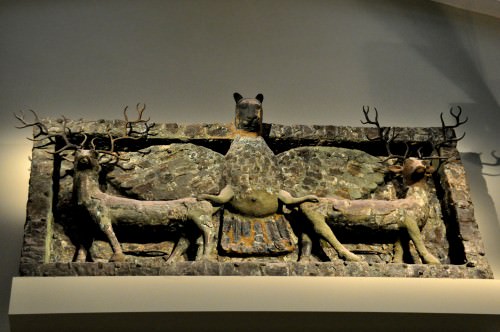
Imdugud Copper Frieze from the Ninhursag Temple
In the second part, Enki is described as a lustful god. He has sexual intercourse with several goddesses and impregnates first Ninhursag, then her daughter Ninmu and then even Ninkurra, who is the daughter of Ninmu. After Ninkurra gives birth to Uttu, Ninhursag advised her: "from in the marsh Enki is able to see up here." However, Uttu opened her door for a gardener (Enki) who came with cucumbers, apples, and grapes and "made love to the youngster and kissed her. Enki poured semen into Uttu's womb and she conceived the semen in the womb, the semen of Enki."
Ninhursag then curses the name Enki and he receives eight diseases from this curse and is in danger of dying. All the other gods are mourning Enki but after a fox has dealt with Enlil she heals him, starting with the words:
My brother, what part of you hurts you?
The last line of the myth is “Praise be to Father Enki” and emphasizes the glorification of Enki.
'I DID IT, IN DEFIANCE OF YOU! I MADE SURE LIFE WAS PRESERVED!' - ENKI
ATRAHASIS
In the legend of Atrahasis (written c. mid-17th century BCE) Enki arises as the preserver of life on earth. Young divinities had to maintain rivers and canals, but after several years these gods complained about the hard work and finally rebelled. Instead of punishing the rebels, Enki, who is also the wise counselor of the immortals, suggested creating human beings to do the work. At the end of the epic Enlil decided to destroy humankind with a flood but Enki warns the hero Atrahasis to rescue him.At last Enki spoke to the great gods: 'I did it, in defiance of you! I made sure life was preserved!' It is remarkable that the part of the flood story has been almost literally adapted into the Epic of Gilgamesh.
ENMERKAR & THE LORD OF ARATTA
The Sumerian epic entitled Enmerkar and the Lord of Aratta, composed c. 21st century BCE is deemed to be the longest Sumerian epic yet discovered and is often compared with the Tower of Babel narrative in the Book of Genesis. In a speech of Enmerkar (King of Uruk ), Enki is called upon to be a confuser of languages. Moreover, this epic is about the rivalry between the cities of Uruk and Aratta. With the help of Inanna, Enmerkar will get precious metals and stones out of Aratta. From line 38:
My sister, let Aratta fashion gold and silver skilfully on my behalf for Unug.
Kramer's translation of Enki's part in that epic is as follows:
Enki, the lord of abundance whose commands are trustworthy. The lord of wisdom, who understands the land, the leader of the gods, endowed with wisdom, the lord of Eridu changed the speech in their mouths, brought contention into it, into the speech of man that until then had been one.
ENKI & INANNA
The myth of “Enki and Inanna” tells the story of Inanna's journey from Uruk to visit Enki at Eridu. Enki attempts to seduce her during a feast but Inanna, the young goddess blindsided him to get drunk and take all the gifts of his me-s (Tablets of destiny).In his lordliness, he noticed only the next morning, that he has given them to Inanna. So he sends his demons to recover his me-s. Inanna escapes and arrives safely back at Uruk. Enki realizes that he has been blindsided and accepts a permanent peace treaty with Uruk. The dating of this composition is unclear but possibly not before the UR-III-Period (Adam Falkenstein, CRRA II 15).
ENUMA ELISH
In the epic Enuma Elish, the Babylonian creation myth, Enki played a major role in one of the different versions. The epic has been recorded in Old Babylonian on seven clay tablets in Sumero-Akkadian cuneiform script, dated c. 1100 BCE. It is about the birth of the gods and the creation of the universe and human beings. Tiamat is warning Enki that Apsu will kill the younger gods (advised by his Vizier, Mummu) because they are too noisy. Enki is killing Apsu and creating his home from Apsu's remains. With the help of Quingu, Tiamat is then fighting against Enki and the younger gods because they have killed her mate Apsu.
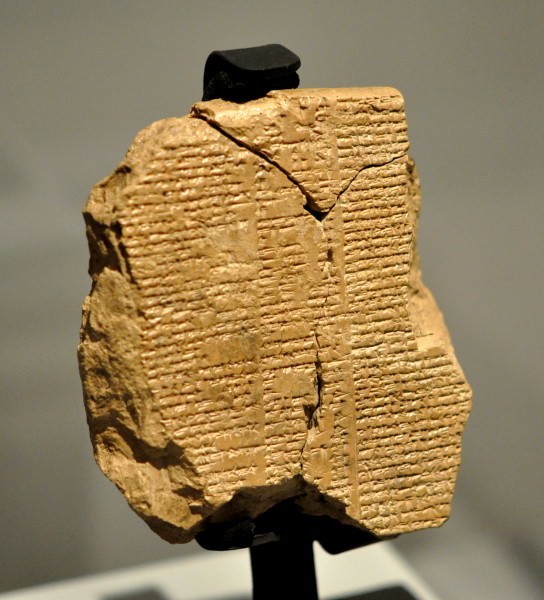 PART OF TABLET V, THE EPIC OF GILGAMESH
PART OF TABLET V, THE EPIC OF GILGAMESH

THE DEATH OF GILGAMESH
Enki's intimate role in relation to Gilgamesh, the semi-mythic King of Uruk seems to be most important in the composition titled The Death of Gilgamesh (written c. 2150-1400 BCE). He is the god who decides the fate of Gilgamesh. This composition is about the dying process and burial rituals of Gilgamesh and describes in the first part two dreams of the king where his future death is predicted. The dreams are possibly sent by Enki titled Nudimmud. In his dreams, Gilgamesh saw the gods holding a meeting to decide his fate. An and Enlil want to save the life of Gilgamesh because of his heroic exploits in Sumer but Enki answers that when the gods had decided to send a flood, only Ziusudra was meant to be saved. Enki has to swear that no man beside Ziusudra will ever gain eternal life and therefore Enki himself makes a decision that Gilgamesh has to die.
CONCLUSION
The foremost qualities of the Sumerian God Enki, as portrayed in the above literary sources, seem to be creation and birth via his main attributes of wisdom and intelligence. However, he is also the bringer of troubles and death. A strong relationship to mankind can be identified and he is clearly associated with Eridu and Abzu. He is characterized as powerfull and as the holder of the holy me-s.
LICENSE
Article based on information obtained from these sources:with permission from the Website Ancient History Encyclopedia
Content is available under License Creative Commons: Attribution-NonCommercial-ShareAlike 3.0 Unported. CC-BY-NC-SA License
RELATED CONTENTS POSTS 4